英语中考复习课件阅读理解技巧初三总复习阅读策略课件(共15张ppt)
文档属性
| 名称 | 英语中考复习课件阅读理解技巧初三总复习阅读策略课件(共15张ppt) | 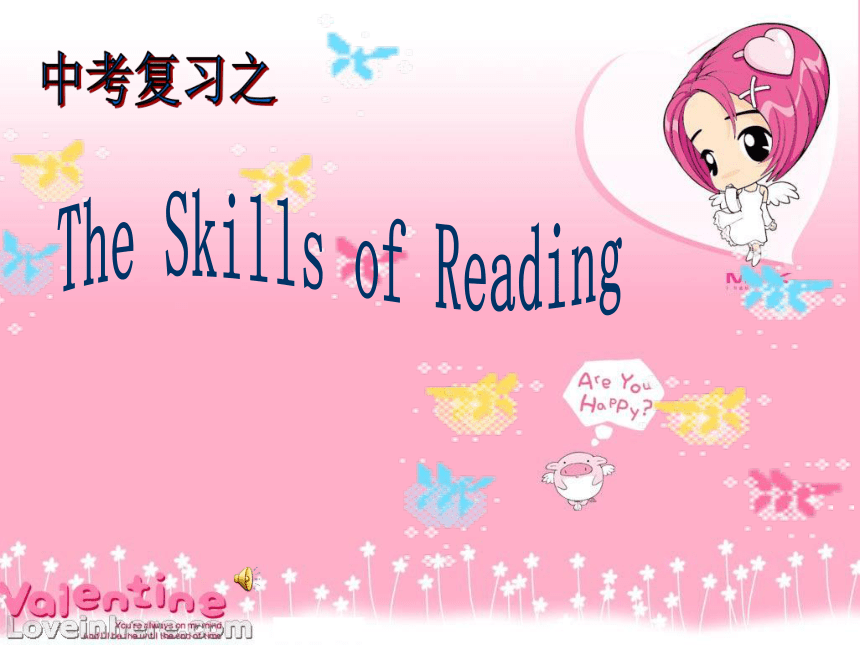 | |
| 格式 | zip | ||
| 文件大小 | 1.1MB | ||
| 资源类型 | 教案 | ||
| 版本资源 | 牛津深圳版 | ||
| 科目 | 英语 | ||
| 更新时间 | 2022-07-22 10:26:03 | ||
图片预览

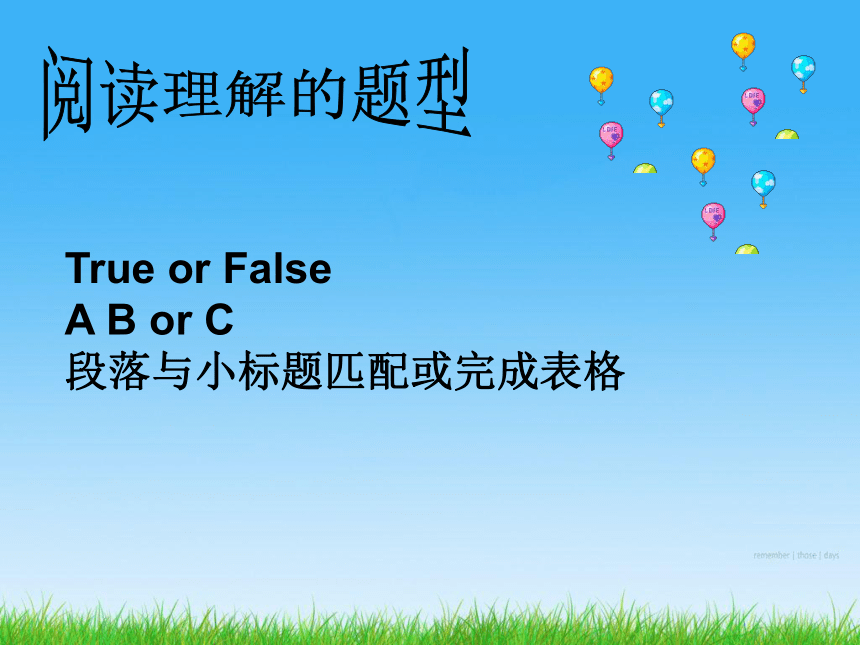
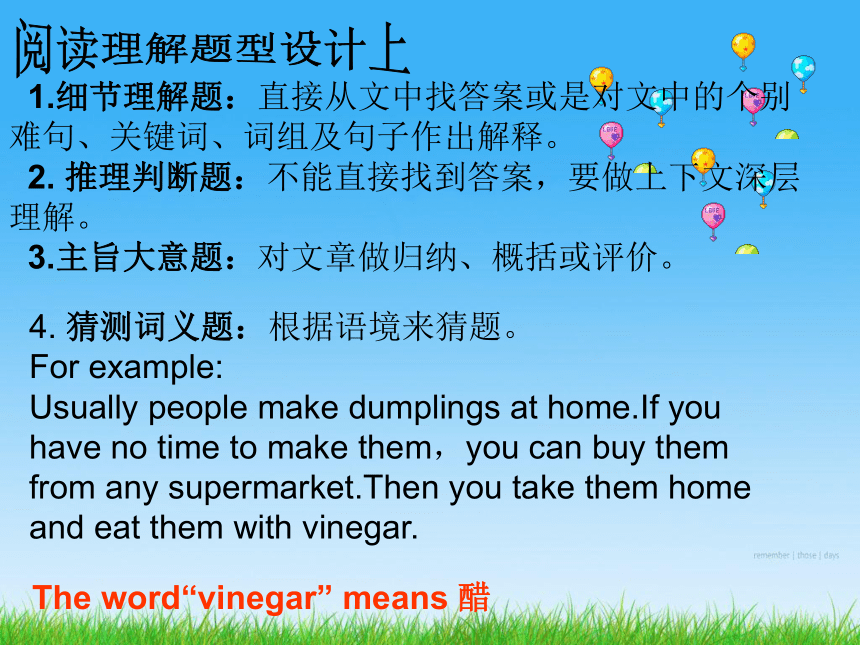
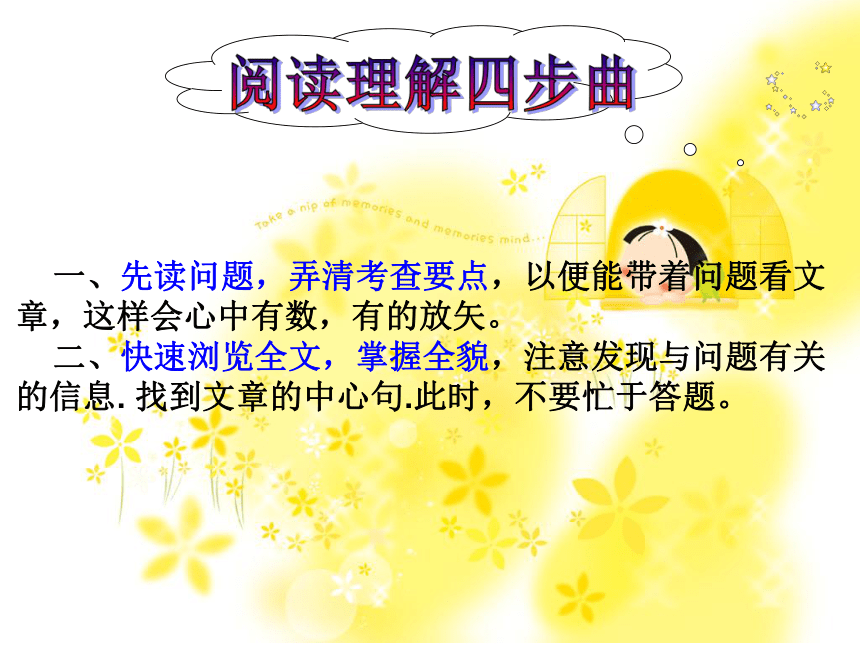
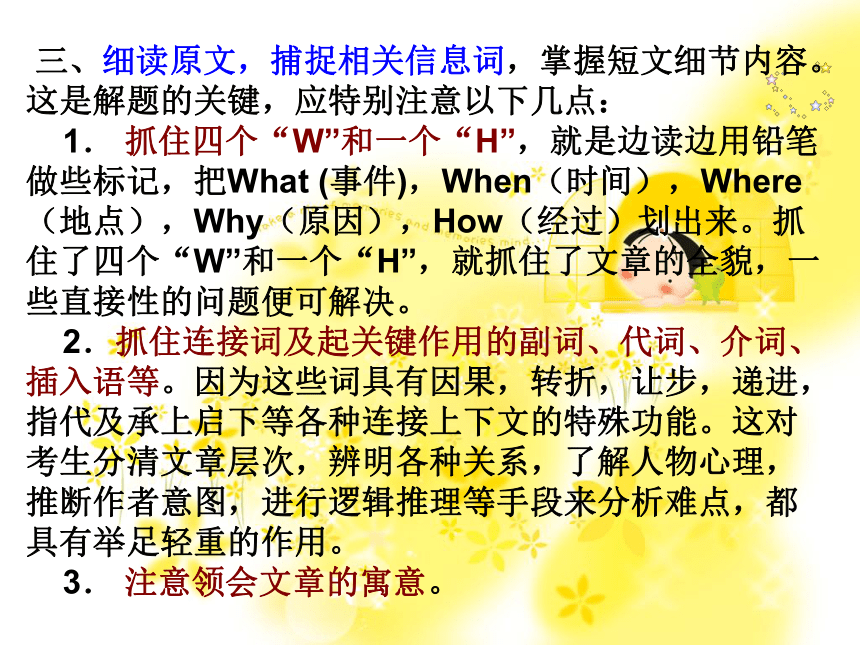
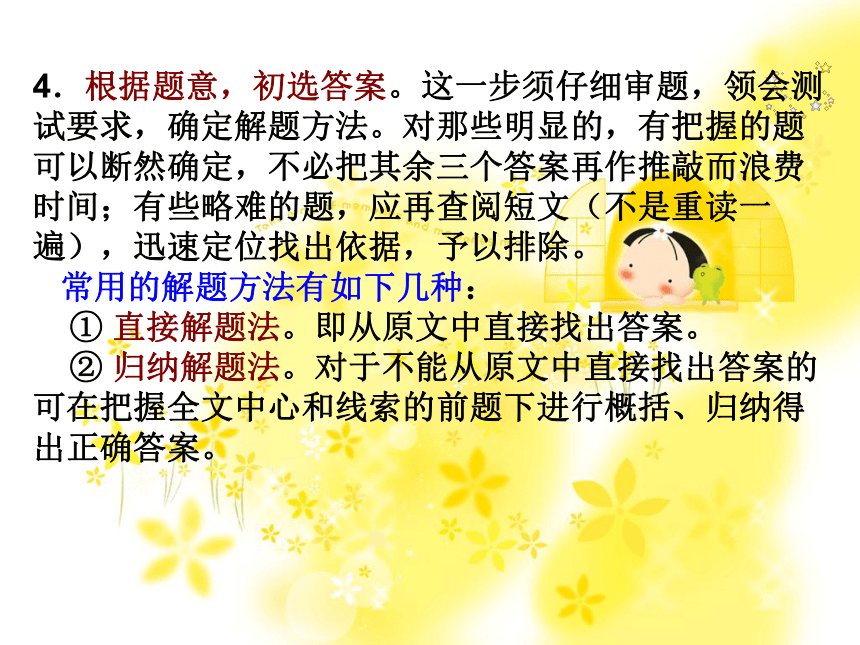
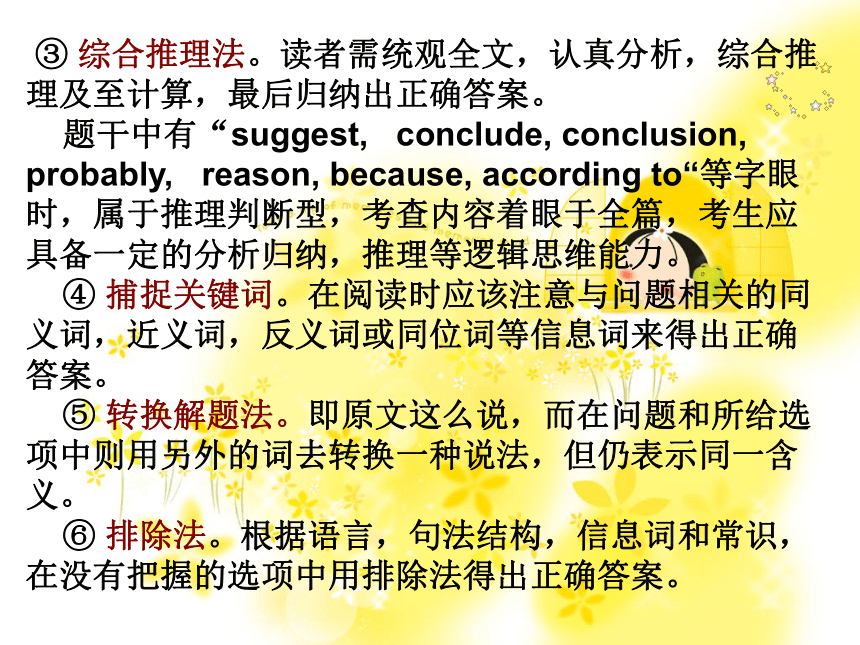
文档简介
(共15张PPT)
True or False
A B or C
段落与小标题匹配或完成表格
1.细节理解题:直接从文中找答案或是对文中的个别难句、关键词、词组及句子作出解释。
2. 推理判断题:不能直接找到答案,要做上下文深层理解。
3.主旨大意题:对文章做归纳、概括或评价。
4. 猜测词义题:根据语境来猜题。
For example:
Usually people make dumplings at home.If you
have no time to make them,you can buy them from any supermarket.Then you take them home and eat them with vinegar.
The word“vinegar” means 醋
一、先读问题,弄清考查要点,以便能带着问题看文章,这样会心中有数,有的放矢。 二、快速浏览全文,掌握全貌,注意发现与问题有关的信息. 找到文章的中心句.此时,不要忙于答题。
三、细读原文,捕捉相关信息词,掌握短文细节内容。这是解题的关键,应特别注意以下几点: 1. 抓住四个“W”和一个“H”,就是边读边用铅笔做些标记,把What (事件),When(时间),Where(地点),Why(原因),How(经过)划出来。抓住了四个“W”和一个“H”,就抓住了文章的全貌,一些直接性的问题便可解决。 2.抓住连接词及起关键作用的副词、代词、介词、插入语等。因为这些词具有因果,转折,让步,递进,指代及承上启下等各种连接上下文的特殊功能。这对考生分清文章层次,辨明各种关系,了解人物心理,推断作者意图,进行逻辑推理等手段来分析难点,都具有举足轻重的作用。 3. 注意领会文章的寓意。
4.根据题意,初选答案。这一步须仔细审题,领会测试要求,确定解题方法。对那些明显的,有把握的题可以断然确定,不必把其余三个答案再作推敲而浪费时间;有些略难的题,应再查阅短文(不是重读一遍),迅速定位找出依据,予以排除。
常用的解题方法有如下几种: ① 直接解题法。即从原文中直接找出答案。 ② 归纳解题法。对于不能从原文中直接找出答案的可在把握全文中心和线索的前题下进行概括、归纳得出正确答案。
③ 综合推理法。读者需统观全文,认真分析,综合推理及至计算,最后归纳出正确答案。 题干中有“suggest, conclude, conclusion, probably, reason, because, according to“等字眼时,属于推理判断型,考查内容着眼于全篇,考生应具备一定的分析归纳,推理等逻辑思维能力。 ④ 捕捉关键词。在阅读时应该注意与问题相关的同义词,近义词,反义词或同位词等信息词来得出正确答案。 ⑤ 转换解题法。即原文这么说,而在问题和所给选项中则用另外的词去转换一种说法,但仍表示同一含义。 ⑥ 排除法。根据语言,句法结构,信息词和常识,在没有把握的选项中用排除法得出正确答案。
四、重读原文,仔细斟酌核对答案。在解完最后一道题后,如果时间允许,再将原文读一遍;用全文的主题思想统率各思考题,研究其内在联系和逻辑关系,目的在于对所做答案进一步审查,推出未解答的题,以便减少失误。
EXERCISE
A
David McConnell sold books from door to door. Housewives(家庭主妇)were not interested in the books. Usually before he had enough time to say anything about his books, the women closed their doors. But he didn’t give up. McConnell decided to bring each of them a present, a small bottle of perfume(香水)made by himself. He soon found that the women liked the perfume better than the books. He stopped selling books to sell perfume instead and started his own company “Avon”, which is a great success. When you do nothing, you learn nothing. But when you try, even though you are not successful, you will learn what doesn’t work and that puts you closer to what will work. It doesn’t matter how many times you are not successful. It does matter that you will be successful one day.
根据短文内容,判断下列句子是否正确,对的涂(A),错的涂(B) ( ) 1. McConnell was successful as a book-seller. ( ) 2. McConnell hoped those women would buy
his books if he brought them each a present. ( ) 3. If you do nothing at all, you will never be
successful. ( ) 4. Edison was successful at the very beginning. ( ) 5. The writer encouraged us to try as much as
we can.
Edison was not on the way to success until people bought his first invention. Success once is enough for Edison. And the same for you—success once is enough.
B
B
A
A
A
B
Why do we need to throw less away There are two reasons. One is that some resources(资源) are nonrenewable(不可再生的). That means there is only a certain amount of that resouce in the world. One example of this is oil. When we use up all the oil in the world, there will be no more.
There is another reason for throwing less away. All of our trash has to be put somewhere. Often, it is put into garbage dump(垃圾场). Much of that trash will be there for hundreds of years. The dumps will be filled up with all this trash.
There are three ways to cut down on trash.
One way is to recycle. When you recycle something, it means it is made into another shape and used again. Old newspapers may become paper bags. A glass jar can be melted(熔化) and made into a bottle.
Another way to cut down on trash is to reuse things. You can wash and use again a bottle that can hold mustard(芥末酱) or something else.
The third way to cut down on trash is to reduce the amount of trash you make, stop buying things that you don’t need in the first place. That reduces the amount of the earth’s resources that you use.
根据短文内容,选择最佳答案。
1.How many reasons do we need to throw less away _______.
A. Three B. Five C. Two
2. When you reuse something, it means_______.
A . it is made into another shape and used again
B. it is used again.
C. it isn’t used any more
3. All the ways of cutting down on trash in the passage are to _______.
A. recyclw and reuse things
B. recycle and reduce the amount of trash you make
C. reuse things, recycle and reduce the amount of trash you make
4. If a broken plastic box is changed into a plastic ruler, the way is to _______.
A. recycle B. reuse C. reduce
5. The word “reduce” in the passage means_______.
A. 还原 B.减少 C.增加
C
B
C
A
B
hink
C
According to the Center for Disease Control and Prevention(CDCP)(疾病控制预防中心), if you don't often wash your hands, you will be affected by viruses(受病菌侵蚀)from many places and make yourself ill. You’re at risk every time you touch your eyes, nose or mouth. In fact, one of the most common ways people catch colds is by rubbing(揉) their noses or their eyes when there are cold viruses on their hands. If you don’t often wash your hands, especially when you’re sick, you may spread the viruses directly to others. You should wash your hands in the following situations:
After using the bathroom.
After blowing your nose or coughing.
Before eating, serving or preparing food.
After visiting anyone who is sick.
When your hands are dirty.
There’s a right way to wash your hands. Follow these simple steps to keep your hands clean.
Use warm water(not cold or hot).
Wash for 15 seconds.
Wash well under warm ruuning water and dry them with a clean towel.
根据短文内容,在表格中的横线上填写所缺单词。每空一词。
Conditions for spreading illness When your hands are dirty
When you are ________
Time to wash hands After using the ________
After blowing your nose or coughing
________ having food
After ________ sick people
When hands are dirty
Right way to wash hands Use ________ water and wash 15 seconds.
Then wash well.
ill
bathroom
Before
visiting/seeing
warm
True or False
A B or C
段落与小标题匹配或完成表格
1.细节理解题:直接从文中找答案或是对文中的个别难句、关键词、词组及句子作出解释。
2. 推理判断题:不能直接找到答案,要做上下文深层理解。
3.主旨大意题:对文章做归纳、概括或评价。
4. 猜测词义题:根据语境来猜题。
For example:
Usually people make dumplings at home.If you
have no time to make them,you can buy them from any supermarket.Then you take them home and eat them with vinegar.
The word“vinegar” means 醋
一、先读问题,弄清考查要点,以便能带着问题看文章,这样会心中有数,有的放矢。 二、快速浏览全文,掌握全貌,注意发现与问题有关的信息. 找到文章的中心句.此时,不要忙于答题。
三、细读原文,捕捉相关信息词,掌握短文细节内容。这是解题的关键,应特别注意以下几点: 1. 抓住四个“W”和一个“H”,就是边读边用铅笔做些标记,把What (事件),When(时间),Where(地点),Why(原因),How(经过)划出来。抓住了四个“W”和一个“H”,就抓住了文章的全貌,一些直接性的问题便可解决。 2.抓住连接词及起关键作用的副词、代词、介词、插入语等。因为这些词具有因果,转折,让步,递进,指代及承上启下等各种连接上下文的特殊功能。这对考生分清文章层次,辨明各种关系,了解人物心理,推断作者意图,进行逻辑推理等手段来分析难点,都具有举足轻重的作用。 3. 注意领会文章的寓意。
4.根据题意,初选答案。这一步须仔细审题,领会测试要求,确定解题方法。对那些明显的,有把握的题可以断然确定,不必把其余三个答案再作推敲而浪费时间;有些略难的题,应再查阅短文(不是重读一遍),迅速定位找出依据,予以排除。
常用的解题方法有如下几种: ① 直接解题法。即从原文中直接找出答案。 ② 归纳解题法。对于不能从原文中直接找出答案的可在把握全文中心和线索的前题下进行概括、归纳得出正确答案。
③ 综合推理法。读者需统观全文,认真分析,综合推理及至计算,最后归纳出正确答案。 题干中有“suggest, conclude, conclusion, probably, reason, because, according to“等字眼时,属于推理判断型,考查内容着眼于全篇,考生应具备一定的分析归纳,推理等逻辑思维能力。 ④ 捕捉关键词。在阅读时应该注意与问题相关的同义词,近义词,反义词或同位词等信息词来得出正确答案。 ⑤ 转换解题法。即原文这么说,而在问题和所给选项中则用另外的词去转换一种说法,但仍表示同一含义。 ⑥ 排除法。根据语言,句法结构,信息词和常识,在没有把握的选项中用排除法得出正确答案。
四、重读原文,仔细斟酌核对答案。在解完最后一道题后,如果时间允许,再将原文读一遍;用全文的主题思想统率各思考题,研究其内在联系和逻辑关系,目的在于对所做答案进一步审查,推出未解答的题,以便减少失误。
EXERCISE
A
David McConnell sold books from door to door. Housewives(家庭主妇)were not interested in the books. Usually before he had enough time to say anything about his books, the women closed their doors. But he didn’t give up. McConnell decided to bring each of them a present, a small bottle of perfume(香水)made by himself. He soon found that the women liked the perfume better than the books. He stopped selling books to sell perfume instead and started his own company “Avon”, which is a great success. When you do nothing, you learn nothing. But when you try, even though you are not successful, you will learn what doesn’t work and that puts you closer to what will work. It doesn’t matter how many times you are not successful. It does matter that you will be successful one day.
根据短文内容,判断下列句子是否正确,对的涂(A),错的涂(B) ( ) 1. McConnell was successful as a book-seller. ( ) 2. McConnell hoped those women would buy
his books if he brought them each a present. ( ) 3. If you do nothing at all, you will never be
successful. ( ) 4. Edison was successful at the very beginning. ( ) 5. The writer encouraged us to try as much as
we can.
Edison was not on the way to success until people bought his first invention. Success once is enough for Edison. And the same for you—success once is enough.
B
B
A
A
A
B
Why do we need to throw less away There are two reasons. One is that some resources(资源) are nonrenewable(不可再生的). That means there is only a certain amount of that resouce in the world. One example of this is oil. When we use up all the oil in the world, there will be no more.
There is another reason for throwing less away. All of our trash has to be put somewhere. Often, it is put into garbage dump(垃圾场). Much of that trash will be there for hundreds of years. The dumps will be filled up with all this trash.
There are three ways to cut down on trash.
One way is to recycle. When you recycle something, it means it is made into another shape and used again. Old newspapers may become paper bags. A glass jar can be melted(熔化) and made into a bottle.
Another way to cut down on trash is to reuse things. You can wash and use again a bottle that can hold mustard(芥末酱) or something else.
The third way to cut down on trash is to reduce the amount of trash you make, stop buying things that you don’t need in the first place. That reduces the amount of the earth’s resources that you use.
根据短文内容,选择最佳答案。
1.How many reasons do we need to throw less away _______.
A. Three B. Five C. Two
2. When you reuse something, it means_______.
A . it is made into another shape and used again
B. it is used again.
C. it isn’t used any more
3. All the ways of cutting down on trash in the passage are to _______.
A. recyclw and reuse things
B. recycle and reduce the amount of trash you make
C. reuse things, recycle and reduce the amount of trash you make
4. If a broken plastic box is changed into a plastic ruler, the way is to _______.
A. recycle B. reuse C. reduce
5. The word “reduce” in the passage means_______.
A. 还原 B.减少 C.增加
C
B
C
A
B
hink
C
According to the Center for Disease Control and Prevention(CDCP)(疾病控制预防中心), if you don't often wash your hands, you will be affected by viruses(受病菌侵蚀)from many places and make yourself ill. You’re at risk every time you touch your eyes, nose or mouth. In fact, one of the most common ways people catch colds is by rubbing(揉) their noses or their eyes when there are cold viruses on their hands. If you don’t often wash your hands, especially when you’re sick, you may spread the viruses directly to others. You should wash your hands in the following situations:
After using the bathroom.
After blowing your nose or coughing.
Before eating, serving or preparing food.
After visiting anyone who is sick.
When your hands are dirty.
There’s a right way to wash your hands. Follow these simple steps to keep your hands clean.
Use warm water(not cold or hot).
Wash for 15 seconds.
Wash well under warm ruuning water and dry them with a clean towel.
根据短文内容,在表格中的横线上填写所缺单词。每空一词。
Conditions for spreading illness When your hands are dirty
When you are ________
Time to wash hands After using the ________
After blowing your nose or coughing
________ having food
After ________ sick people
When hands are dirty
Right way to wash hands Use ________ water and wash 15 seconds.
Then wash well.
ill
bathroom
Before
visiting/seeing
warm
同课章节目录
- 词法
- 名词
- 动词和动词短语
- 动词语态
- 动词时态
- 助动词和情态动词
- 非谓语动词
- 冠词
- 代词
- 数词和量词
- 形容词副词及其比较等级
- 介词和介词短语
- 连词和感叹词
- 构词法
- 相似、相近词比较
- 句法
- 陈述句
- 一般疑问句和否定疑问句
- 特殊疑问句及选择疑问句
- 反意疑问句
- 存在句(There be句型)
- 宾语从句
- 定语从句
- 状语从句
- 主谓一致问题
- 简单句
- 并列句
- 复合句
- 主谓一致
- 主、表语从句
- 名词性从句
- 直接引语和间接引语
- 虚拟语气
- 感叹句
- 强调句
- 倒装句
- 祈使句
- 句子的成分
- 句子的分类
- 题型专区
- 单项选择部分
- 易错题
- 完形填空
- 阅读理解
- 词汇练习
- 听说训练
- 句型转换
- 补全对话
- 短文改错
- 翻译
- 书面表达
- 任务型阅读
- 语法填空
- 其他资料
